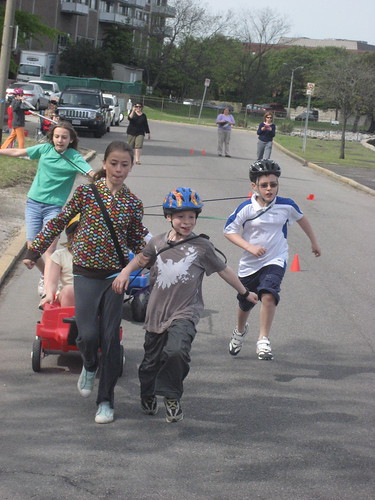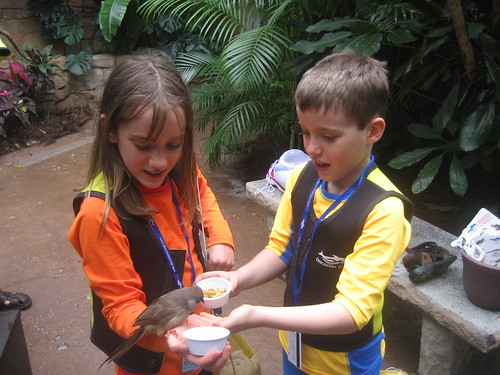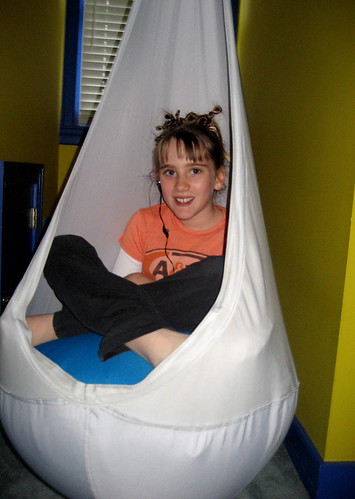
I received a review copy of Jacob's Ladder from Prufrock Press a few months ago and started using it immediately. This is the first time that Ben has enjoyed a comprehension program. He and Shira ask to do Jacob's Ladder and are upset if it isn't included in a day's schedule.
So what is Jacob's Ladder?
Jacob's Ladder is a supplemental reading program that implements targeted readings from short stories, poetry, and nonfiction sources. With this program, students engage in an inquiry process that moves from lower order to higher order thinking skills. Starting with basic literary understanding, students learn to critically analyze text by determining implications and consequences, generalizations, main ideas, and/or creative synthesis.
Jacob's Ladder uses "ladders" to guide the children. Ladder A teaches the children how to draw implications and consequences from their reading. For example, the children read a story about a young boy whose father forced him to shoot a blue heron against the boy's wishes. The story goes on to deal with the what happened after the shooting and how the relationship between the boy and his father changed. Ladder A starts by asking the children to list the five most important events of the story in order. Then it asks why the boy receives a camera for his birthday at the end of the story. (this is because the father finally realizes that the son prefers shooting with film and not bullets). Finally, the children are asked to predict how the story would have been different had any one of 4 different events happened.
Ben and Shira love this final part of ladder A. They like to engage in "what if" scenarios.
Ladder B teaches children to make generalizations from the details in the readings. In the story I discuss when talking about Ladder A, Ladder B starts off by asking the children, "What are the reasons for Jon's father wanting to kill the heron?" and "What are Jon's reasons for not wanting to kill the heron.". They are then asked to classify their answers into positive and negative reasons. Finally they are asked to make generalizations about the following based on the story: a) Hunting, b) People who like to hunt, and c) People who don't like to hunt.
Ladder C focuses on themes. Children start by identifying settings and characters and then make inferences about the literary situation. In the story about Androcles and the Lion Ladder C starts off by asking: "How would you describe Androcles? Support your answer with evidence from the text."
It then goes on to ask, "Why doesn't the LIon eat Androcles? Did it surprise you that the Lion spared him? Why or why not?. Finally it asks the child to write a moral for the fable and to explain why her moral is appropriate, providing evidence from the text.
The final ladder, ladder D, focuses on creative synthesis by leading students through paraphrasing and summarizing activities. In Androcles and the Lion, Ladder D starts off by asking the children to rewrite the following quotation in their own words: "But as soon as he came near to Androcles he recognized his friend, and fawned upon him, and licked his hands like a friendly dog. The Emperor, surprised at this, summoned Androcles to him, who told him the whole story, whereupon the slave was pardoned and freed, and the Lion let loose to his native forest."
Then the children are asked to write the main idea of the fable from Androcles, supporting their answers from the text.
Finally the children synthesize this all by writing another fable about the main idea they identified for this fable, using characters, settings and a plot of their own choice.
Ladders A and D are Ben and Shira's favorite ladders. I should mention that not all ladders are done for each reading.
I find that Jacob's Ladder is easy to use and thoroughly enjoy how it helps light a spark in my children. They truly do not consider working on Jacob's Ladder to be school work, for them, this is a treat. This is in such stark contrast from the reading comprehension programs of my day. I used to be bored out of my mind. Many of the current programs I've seen mimic the ones of my youth and are simply multiple choice questions about facts within the story. Jacob's Ladder is an entirely different animal. It engages higher order thinking and takes the children far beyond the texts they are reading.
This is a good training ground for when the children finally enter the great literary debate when they read the Great Books of the Western World.
This is the first comprehension program that I've seen that I can wholeheartedly recommend. While it's targeted at gifted children, I think that all children will enjoy this program as you can guide the answers as deeply or as shallowly as you wish. If you have children, how like mine, love to engage in philosophizing, this is definitely a program they would enjoy.





























